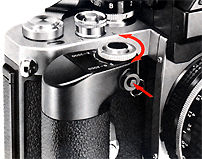MB-1 Battery Pack
The Cordless Battery Pack MB-1 holds ten penlight batteries, or two MN-1 NC Battery
Units, which are available as optional accessories.
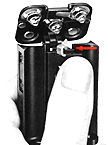 |
Installing the batteries |
Life-span of the batteries The number of rolls that can be shot with one set of batteries varies as follows. Approximately 15 36-exposure rolls can be shot at the guaranteed rated firing speed with zinc-carbon batteries, and approximately 30 rolls with alkaline-manganese batteries, These amounts can be extended to approximately 100 and 160 rolls, respectively, but with a corresponding slowdown in the firing speed. NC battery units have enough power for shooting 80 rolls of film at the rated firing speed, or up to 120 rolls but at slower firing speeds.
 |
This table shows the number of 36-exposure rolls of film which can be fired on one set of batteries. |
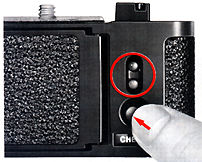 |
To check the battery power, depress the power check button on the side of the battery pack. If both the LED's light up, the batteries have sufficient power. If only the lower LED lights up, the batteries can still be used, but will be exhausted soon. If neither LED lights up, the batteries must be changed. All ten batteries should be changed, since full performance will not be obtained if old and new batteries are mixed. |
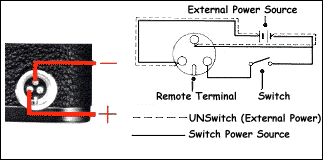 |
Any direct and consistent current between 12 and 15 volts, and more than 1.5 amps, is suitable as a power source. Remember, however, that too much current can damage the motor drive's circuitry. To connect the motor drive to an external power source, plug one end of a suitable cord into the three-pin socket on the motor drive and the other end into the power supply. The diagrams below may be useful in establishing a power circuit. |
Frame Counter The frame counter on the motor drive shows the number of unexposed frames remaining on a roll of film. It is calibrated in even numbers from 0 to 40. The frame counter preset wheel can be rotated in either direction. When the counter reaches zero, the motor will stop automatically.
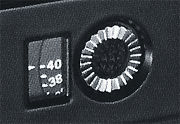 |
If you want a certain number of frames to be set for continuous firing, just set the counter to the desired number. This operation can be done repeatedly. The frame counter on the camera also continues to operate when the motor drive is attached, so you can easily see how many exposures you have left. |
• Be careful to set the number of frames correctly. If you overestimate the number remaining on a roll of film) the result may be that the motor will pull the film off the supply spool or damage its perforated edges, since the motor will continue to operate until the counter reaches zero.
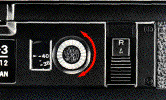 |
• Turning the frame counter's preset wheel away from its zero position when the motor drive is removed from the camera may occasionally result in the motor drive running freely until the counter resets itself to zero. |
This is a normal operating
condition, caused by the end of the film being reached before the motor drive completes
its advance cycle, and is no case for concern. When the motor drive is reattached
to the camera, this condition will be corrected automatically. *
The motor will not operate when the counter is at zero. Always check the counter
before starting to shoot, especially at the beginning of a roll.
Motor Drive Operations Single-frame shooting Depress the SC locking button on the motor drive hand grip and turn the mode selector ring to "S." As soon as the trigger button is released, the motor drive automatically winds on the film and cocks the shutter ready for the next exposure. When using shutter speeds slower than 1/60 sec., be sure to keep the trigger button depressed long enough for the shutter to complete the exposure. Otherwise, the exposure time may be shortened unintentionally. Do not press the trigger while the film is being wound.
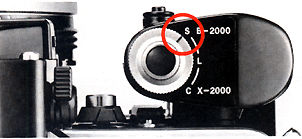 |
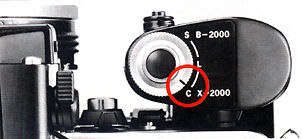 |
Continuous
shooting
Set the mode selector ring to "C." Choose any shutter speed from 1 /80
and faster. As long as the trigger button is held down, the motor drive will continue
to fire automatically. Releasing the button stops the motor drive after it has advanced
the film one frame and cocked the shutter for the next exposure.
|
The number of frames shot per second will vary according to the power source used. The table below illustrates these variations. |
||||||||||||||||||||
Film Rewinding When the roll of film in the camera has been exposed, press the rewind slide up as far as it will go.
 |
Then unfold the rewind crank on the camera body and turn it to rewind the film. When the film is fully rewound, turn the O/C knob to open the camera back, and remove the film cartridge. |
Note: Power Film rewind is NOT availble in this model.
Double
/ Multiple Exposure Operations You have a choice of two operational modes
for making double or multiple exposures with your motorized F2, either "S"
or "C." The "S" setting is recommended for photographic
situations where a deliberate composition is aimed for; the "C"
setting is more suitable for special effects such as multiple images of a moving
subject on a single frame.
Using "S" setting First, set the mode selector to
"S." and remember the number shown in the frame counter of the motor drive.
(A) For double exposures:
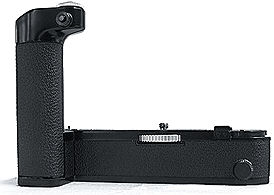 |
I . Push the rewind slide up as far as it will go; this will disengage the film transport mechanism. Then release the slide. |
3. Trigger the shutter for
the second exposure. Releasing your finger from the trigger button will result in
the film advancing normally and the shutter recocking ready for the next ordinary
exposure.
4. Reset the frame counter of the motor drive to read one frame less than the number
shown before making the double exposure.
(B) For multiple exposures:
I . Push the rewind slide up and hold it up for the duration of the multiple exposure
session.
2. Make the number of exposures you require, and release the rewind slide.
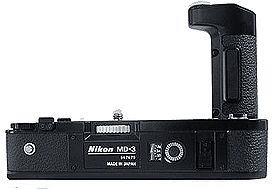 |
3. After completing the last exposure, make two blank exposures with the lens covered with a lens cap. These blank exposures are to reset the film transport mechanism and to advance the film ready for the next ordinary exposure or set of multiple exposures. |
| Previous | Next | 2/3 Frame counter, Accessories, Remote, External Power options and Specifications.
| Nikon MD-1 | MD-2 | MD-3 | MD-100 |
| System Accessories for Motor Drives |
| Back | Main Index Page - F2 Motor Drive Options
| Message Board |
for
your favourite Nikon
F2 Series SLR model(s)
| Message Board | for your Nikon Optics in a shared environment
| Message Board | Specifically for Dispose or Looking for Nikon/Nikkor Photographic
Equipment
| Back | to Main Index Page of Nikon F2 Series SLR models
| Back |
Main Index Page of Pictorial History of Nikon SLRs
 |
The Eyes of Nikon:- |
Fisheye-Nikkor Lenses - Circular | Full Frame | Ultrawides Lenses - 13mm15mm18mm20mm | Wideangle Lenses - 24mm28mm35mm |
Standard Lenses - 45mm 50mm 58mm | Telephoto Lenses - 85mm105mm135mm180mm & 200mm |
Super-Telephoto Lenses - 300mm 400mm 500mm 600mm 800mm 1200mm |
Special Application lenses:
Micro-Nikkor Lenses - 50mm~55mm -60mm 85mm -105mm 200mm Micro-Zoom 70-180mm
Perspective Control (PC) - 28mm 35mm PC-Micro 85mm
Dedicated Lenses for Nikon F3AF: AF 80mm f/2.8 | AF 200mm f/3.5 EDIF
Depth of Field Control (DC): 105mm 135mm
Medical Nikkor: 120mm 200mm
Reflex-Nikkor Lenses - 500mm 1000mm 2000mm
Others: Noct Nikkor | OP-Nikkor | UV Nikkor 55mm 105mm | Focusing Units | Bellows-Nikkor 105mm 135mm
Nikon Series E Lenses: 28mm35mm50mm100mm135mm | E-Series Zoom lenses: 36~72mm75~150mm70~210mm
MF Zoom-Nikkor Lenses: 25~50mm | 28~45mm | 28~50mm | 28~85mm | 35~70mm | 36~72mm E | 35~85mm | 35~105mm | 35~135mm |
35~200mm | 43~86mm | 50~135mm | 50~300mm | 70~210mm E | 75~150mm E | 80~200mm | 85~250mm |
100~300mm | 180~600mm | 200~400mm | 200~600mm | 360~1200mm | 1200~1700mm
Tele-Converters: TC-1 | TC-2 | TC-200 | TC-201 | TC-300 | TC-301 | TC-14 | TC-14A | TC-14B | TC-14C | TC-14E | TC-16 | TC-16A | TC-20E
![]()
Nikon F
| Nikon F2 |
Nikon
F3
| Nikon F4 |
Nikon
F5
| Nikon F6 |
Nikkormat / Nikomat |
Nikon FM
| Nikon FE/ FA | Nikon EM/FG/FG20 | Nikon Digital SLRs | Nikon - Other models
MIR Supports for Photographic Community: Various Message Boards/Community
Forums
Nikon
F-series|
Nikon
F2-series|
Nikon
F3-series|
Nikon F4-series| Nikon
F5-series|Nikkormat/Nikomat-series
Nikon FM-series|Nikon
FE-series|Nikon
FA|Nikon
Digital
SLR
series|Various
Nikon
Models|Nikkor
Optic
-shared
Others:- Free Trade Zone - Photography| Free Trade Zone - Business Community |Free To Zouk - Photographic Community
Apple's Mac Public Community Message Board | Windows based PC &
Apple/Mac
Public Community Trade Exchange Centre
Recommended links to understand
more technical details related to the Nikkor F-mount and production Serial Number:
http://rick_oleson.tripod.com/index-153.html by: my friend, Rick Oleson
http://www.zi.ku.dk/personal/lhhansen/photo/fmount.htm by: Hansen, Lars Holst
http://www.mir.com.my/rb/photography/hardwares/nikonfmount/lens2.htm
http://www.photosynthesis.co.nz/nikon/serialno.html
About this photographic site.
HOME - Photography in Malaysia |
Copyright © 2000. leofoo ®. MIR Web Development Team.
In
memory of my friend Com.
Augusto Staut,
Brazil, 1971-2000.
Credit: Chuck Hester, US for his patience, encouragement
and help to setup the various content in this site; Robert Johnson for some of his original
images on the F2H-MD appeared in this site; my ex-staff, KiaSu for his superb
3-D logo appeared in this Nikon F2 site; Marc Vorgers from Holland who
generously provide me with some of his images of F2AS; MCLau®, who has so much time with me to
re-edit the content in this site and not to mention buying a Nikon Coolpix 990 just
for this site. Keat Photo,
Kuala Lumpur for providing
their Nikon F2A to take some images for this site; again, Mr Edward Ngoh the
great camera collector who provides us his collection of F2AS with MD-2; hawkeye.photographic.com
for their images on the Speed Magny film backs; Sean Cranor for his image
on Nikon F2 25th Anniversary Model; Ted Wengelaar®, Holland for his continuous
flow of input on some of the early Nikon bodies; CYLeow ® , photo editor of the Star
newspaper, Malaysia for some of his images used in this site. Ms Rissa Chan, Sales manager from
Shriro Malaysia who has helped to provide some of the very useful input. HiuraShinsaku®,
Nikomat ML, Japan for some of his images on various F2 models; my staff, Wati, Maisa, Mai and my nephew, EEWyn®, who volunteered and helping me
did so many of the film scanning works. Contributing photographers or resellers:
Jen Siow, Foo KokKin, Arthur Teng, Mark Fallander, John
Ishii, Ed Hassel, YoonKi Kim, Jean-Louis, M.Dugentas (Dell Corner.com.), Mr "Arsenall" and a few images mailed
in from surfers with no appropriate reference to their origin. Dedicated to KU Yeo, just to express our mutual regrets over the outcome of
a recent corporate event. Made with a PowerMac, broadcast with a Redhat Linux powered server.

